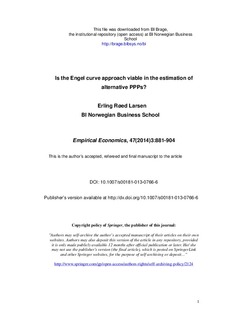| dc.contributor.author | Røed Larsen, Erling | |
| dc.date.accessioned | 2015-08-10T09:34:50Z | |
| dc.date.available | 2015-08-10T09:34:50Z | |
| dc.date.issued | 2014 | |
| dc.identifier.citation | Empirical Economics, 47(2014)3:881-904 | nb_NO |
| dc.identifier.issn | 0377-7332 | |
| dc.identifier.issn | 1435-8921 | |
| dc.identifier.uri | http://hdl.handle.net/11250/295826 | |
| dc.description | This is the author’s accepted, refereed and final manuscript to the article | nb_NO |
| dc.description.abstract | Conventional estimates of purchasing power parities (PPP) rely on cross-country price data. Using Engel curves, Almås (2012) was able to show, however, that PPPs contain substantial bias. Since constructing conventional estimates is expensive and time-consuming, Almås’ idea of employing Engel curves is welcome. This article examines the viability of the Engel curve approach to PPP and its sensitivity to differences in relative prices and preferences by estimating Engel curves not only between countries but also for regions within a given country. My empirical evidence from the United States and Norway suggests that the differences can be problematic, but not sufficiently to discredit the new methodology. A pragmatic approach to PPP estimation between countries that are different is to compute a PPP band, rather than a point estimate. I present a practical example of this using expenditure data from 2001, which yields a band for NOK and U.S. dollar. | nb_NO |
| dc.language.iso | eng | nb_NO |
| dc.publisher | Springer | nb_NO |
| dc.title | Is the Engel curve approach viable in the estimation of alternative PPPs? | nb_NO |
| dc.type | Journal article | nb_NO |
| dc.type | Peer reviewed | nb_NO |
| dc.source.journal | Empirical Economics | nb_NO |
| dc.identifier.doi | 10.1007/s00181-013-0766-6 | |
| dc.description.localcode | 1, Forfatterversjon | nb_NO |
